Understanding AMD’s Mantle: A Low-Level Graphics API For GCN
by Ryan Smith on September 26, 2013 7:20 AM EST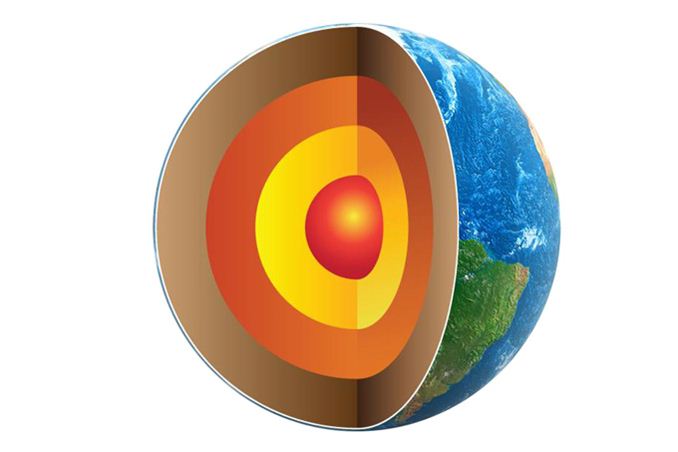
Wrapping up our AMD product showcase coverage for the week, AMD’s final announcement for the showcase was a very brief announcement about a new API called Mantle. Mantle is something of an enigma at this point – AMD isn’t saying a whole lot until November with the AMD Developer Summit – and although it’s conceptually simple, the real challenge is trying to understand where it fits into AMD’s product strategy, and perhaps more importantly what brought them to this point in the first place. So although we don’t have all of the necessary details in hand quite yet, we wanted to spend some time breaking down the matters surrounding Mantle as much as we reasonably can.
Perspective #1: The Performance Case
The best place to start with Mantle is a high level overview. What is Mantle? Mantle is a new low-level graphics API specifically geared for AMD’s Graphics Core Next architecture. Whereas standard APIs such as OpenGL and Direct3D operate at a high level to provide the necessary abstraction that makes these APIs operate across a wide variety of devices, Mantle is the very opposite. Mantle goes as low as is reasonably possible, with minimal levels of abstraction between the code and the hardware. Mantle is for all practical purposes an API for doing bare metal programming to GCN. The concept itself is simple, and although low-level APIs have been done before, it has been some time since we’ve seen anything like this in the PC space.
Simplicity gives way to complexity however when we begin discussing not just what Mantle is, but why it exists. At the highest level Mantle exists because high level API have drawbacks in exchange for their ability to support a wide variety of GPUs. Abstractions in these APIs hide what the hardware is capable of, and the code that holds those abstractions together comes with its own performance penalty. Of all of those performance issues the principle issue at hand is the matter of draw calls, which are the individual calls sent to the GPU to get objects rendered. A single frame can be composed of many draw calls, upwards of a hundred or more, and every one of those draw calls takes time to set up and submit.
Although the issue will receive renewed focus today with the announcement of Mantle, we have known for some time now that groups of developers on both the hardware and software side of game development have been dissatisfied with draw call performance. Microsoft and the rest of the Direct3D partners addressed this issue once with Direct3D 10, which significantly cut down on some forms of overhead.
But the issue was never entirely mitigated, and to this day the number of draw calls high-end GPUs can process is far greater than the number of draw calls high-end CPUs can submit in most instances. The interim solution has been to attempt to use as few draw calls as possible – GPU utilization takes a hit if the draw calls are too small – but there comes a point where a few large draw calls aren’t enough, and where the CPU penalty from generating more draw calls becomes notably expensive.
Ergo: Mantle. A low-level API that cuts the abstraction and in the process makes draw calls cheap (among other features).
Perspective #2: The Console Connection
However even with a basic understanding of draw calls and their overhead, so far we haven’t really explained why Mantle exists, and indeed the entire frame of reference that Mantle resides in requires better understanding just why it exists. If Mantle was merely about providing a new low level API for GCN, then the issue would be far more straightforward, and Mantle in most likelihood remain an underutilized curiosity. Instead we have to talk about what is not said and not even hinted at, but what is more critical than Mantle’s performance improvements: the console connection.
As the supplier of the APUs in both the Xbox One and PS4, AMD is in a very interesting place. Both of these upcoming consoles are based on their GCN technology, and as such AMD owns a great deal of responsibility in developing both of these consoles. This goes not only for their hardware but also portions of their software stack, as it’s AMD that needs to write the drivers and AMD that needs to help develop the APIs these consoles will use, so that the full features of the hardware are made available to developers.
At the same time, when it comes to writing APIs we also have to briefly mention the fact that unlike the PC world, the use of both high level and low level APIs are a common occurrence in console software. High level APIs are still easier to use, but when you’re working with a fixed platform with a long shelf life, low level APIs not only become practical, they become essential to extracting the maximum performance out of a piece of hardware. As good as a memory manager or a state manager is, if you know your code inside and out then there are numerous shortcuts and optimizations that are opened up by going low level, and these are matters that hardcore console developers will chase in full. So when we talk about AMD writing APIs for the new consoles, we’re really talking about AMD writing two APIs for the new consoles: a high level API, equivalent to the likes of Direct3D and OpenGL, and a low level API suitable for banging on the hardware directly for maximum performance.
This brings us to the crux of the matter: what’s not being said. Simply put, what would happen if you ported both the high level and low level APIs from a console – say the Xbox One – back over to the PC? We already know what that high level API would look like, because it exists today in the form of Direct3D 11.2, an API peppered with new features that coincide with AMD GCN hardware features. But what about a low level API? What would it look like?
What’s not being said, but what becomes increasingly hinted at as we read through AMD’s material, is not just that Mantle is a low level API, but rather Mantle is the low level API. As in it’s either a direct copy or a very close derivative of the Xbox One’s low level graphics API. All of the pieces are there; AMD will tell you from the start that Mantle is designed to leverage the optimization work done for games on the next generation consoles, and furthermore Mantle can even use the Direct3D High Level Shader Language (HLSL), the high level shader language Xbox One shaders will be coded against in the first place.
Let’s be very clear here: AMD will not discuss the matter let alone confirm it, so this is speculation on our part. But it’s speculation that we believe is well grounded. Based on what we know thus far, we believe Mantle is the Xbox One’s low level API brought to the PC.
If indeed Mantle is the Xbox One’s low level API, then this changes the frame of reference for Mantle dramatically. No longer is Mantle just a new low level API for AMD GCN cards, whose success is defined by whether AMD can get developers to create games specifically for it, but Mantle becomes the bridge for porting over Xbox One games to the PC. Developers who make extensive use of the Xbox One low level API would be able to directly bring over large pieces of their rendering code to the PC and reuse it, and in doing so maintain the benefits of using that low-level code in the first place. Mantle will not (and cannot) preclude the need for developers to also do a proper port to Direct3D – after all AMD is currently the minority party in the discrete PC graphics space – but it does provide the option of keeping that low level code, when in the past that would never be an option.
Perspective #3: Developers, Developers, Developers
With that said, the potential for Mantle is not the same as the actual execution for Mantle, and even if we’re correct about Mantle’s Xbox One origins, Mantle’s success is far from guaranteed. Mantle right now is merely the toolset to realize the possibility of bringing over existing low level code to the PC. To be successful, AMD at a minimum needs to convince multiplatform developers that it’s worth their time to do Mantle enabled versions of their rendering engines, as despite the easy porting it’s still more work than just doing the typical Direct3D port. Even then, that only captures multiplatform ports; native PC games are another matter entirely. Mantle does not necessarily need native PC games to be successful for AMD, but certainly it would strongly validate the existence and capabilities of Mantle if AMD was able to get native PC games developed against it too. After all, the draw call benefits of Mantle are still very real, regardless of which platform is the lead platform for a game.
In fact the significance of developers in this entire process should not be understated. Mantle exists because it’s faster than high level APIs, it makes porting low level console code to the PC easier, and as it turns out, because it’s something developers have been telling AMD they want. More than anything else about Mantle, this is the point AMD has been trying to drive home, as they are well aware of the potential controversy Mantle would bring. Mantle doesn’t just exist because AMD wants to leverage their console connection, but Mantle exists because developers want to leverage it too, and indeed developers have been coming to AMD for years asking for such a low level API for this very reason. As such the impression we're getting from AMD – or at least the impression they're trying their best to give off – is that Mantle was created to satisfy these requests, rather than being something AMD created and is trying to drum up interest for after the fact.
The first game to use Mantle will be Battlefield 4, and as part of the Mantle announcement AMD had DICE put together a video for today’s product showcase, in which they spent some time discussing their own interest in Mantle and low level APIs. It’s one thing for AMD to claim that developers want Mantle – something that would be difficult for the press and consumers to validate – but it’s something else entirely when developers are willing to put together lengthy testimonials in support of Mantle. To that end DICE is just one developer, but with any luck for AMD they are the first of many developers. If AMD’s claims about developers asking for this are true, then we should be able to see for ourselves soon enough if and when more developers pledge support for the API.
Perspective #4: The Drawbacks of Low Level APIs
With all of that in mind, while Mantle has the potential to provide benefits to users and developers alike, there are also some very clear downsides to using a low level API in PC game development.
Unlike consoles, PCs are not fixed platforms, and this is especially the case in the world of PC graphics. If we include both discrete and integrated graphics then we are looking at three very different players: AMD, Intel, and NVIDIA. All three have their own graphics architectures, and while they are bound together at the high level by Direct3D feature requirements and some common sense design choices, at the low level they’re all using very different architectures. The abstraction provided by APIs like Direct3D and OpenGL is what allows these hardware vendors to work together in the PC space, but if those abstractions are removed in the name of performance then that compatibility and broad support is lost in the process.
A lot of press – ourselves included – immediately began comparing Mantle to Glide. Glide was another low level API that was developed by the long-gone GPU manufacturer 3dfx, and at the height of their power in the mid-to-late 90s 3dfx wielded considerable influence thanks to Glide. Glide was easier to work with than the immature Direct3D API, and for a time games either supported only Glide, or supported Glide alongside Direct3D or OpenGL. Almost inevitably the Glide rendering path was better in some respect, be it performance, features, or a general decrease in bugs. This was fantastic for 3dfx card owners, but as both AMD (nee ATI) and NVIDIA can tell you, this wasn’t great for those parties that were on the outside.
As a result of this, as great as Glide was at the time, it’s widely considered a good thing that Glide died out and that Direct3D took over as the reigning king of PC graphics APIs. Developers stopped utilizing multiple rendering paths, and their single rendering path was better for everyone as a result. Having games written exclusively in a common, industry standard API was better for everyone.
Mantle by its very nature reverses that, by reestablishing a low level API that exists at least in part in competition with Direct3D and OpenGL. Consequently while Mantle is good for AMD users, is Mantle good for NVIDIA and Intel users? Do developers start splitting their limited resources between Mantle and Direct3D, spending less time and resources on their Direct3D rendering paths as a result?
At the risk of walking a very fine line here, like so many aspects of Mantle these are not questions we have the answer to today. And despite the reservations this creates over Mantle this doesn’t mean we believe Mantle should not exist. But these are real concerns, and they are concerns that developers will need to be careful to address if they intend to use Mantle. Mantle’s potential and benefits are clear, but every stakeholder in PC game production needs to be sure that Mantle doesn’t lead to a repeat of the harmful aspects of Glide.
Final Words
When AMD first told us about their plans for Mantle, it was something we took in equal parts of shock, confusion, and awe. The fact that AMD would seek to exploit their console connection was widely expected, however the fact that they would do so with such an aggressive move was not. If our suspicions are right and AMD is bringing over the Xbox One low level API, then this means AMD isn’t just merely exploiting the similarities to Microsoft’s forthcoming console, but they are exploiting the very heart of their console connection. To bring over a console’s low level graphics API in this manner is quite simply unprecedented.
However at this point we’ve just scratched the surface of Mantle, and AMD’s brief introduction means that questions are plenty and answers are few. The potential for improved performance is clear, as are the potential benefits to multiplatform developers. What’s not clear however is everything else: is Mantle really derived from the Xbox One as it appears? If developers choose to embrace Mantle how will they do so, and what will the real performance implications be? How will Mantle be handled as the PC and the console slowly diverge, and PC GPUs gain new features?
The answers to those questions and more will almost certainly come in November, at the 2013 AMD Developer Summit. In the interim however, AMD has given us plenty to think about.


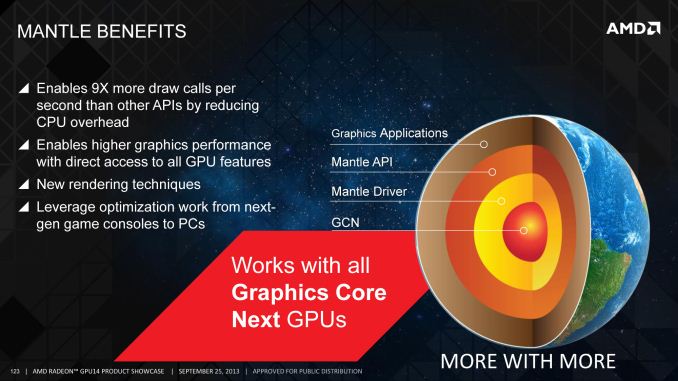
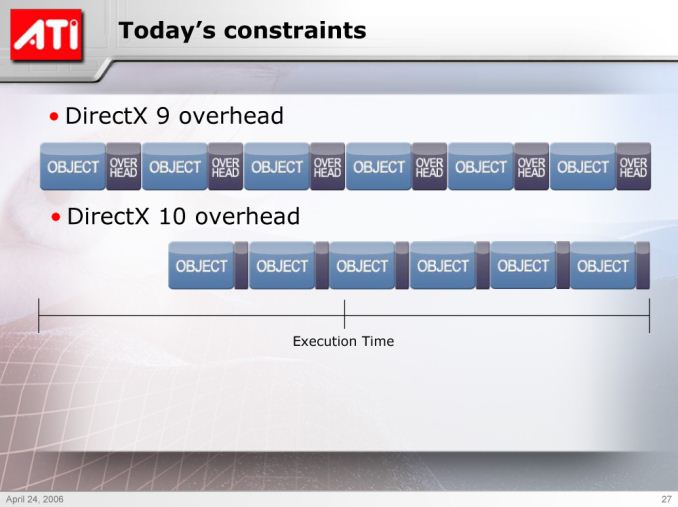
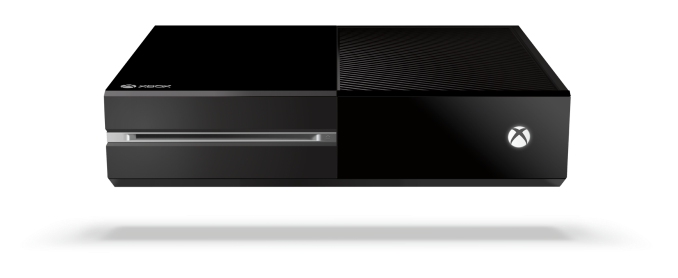
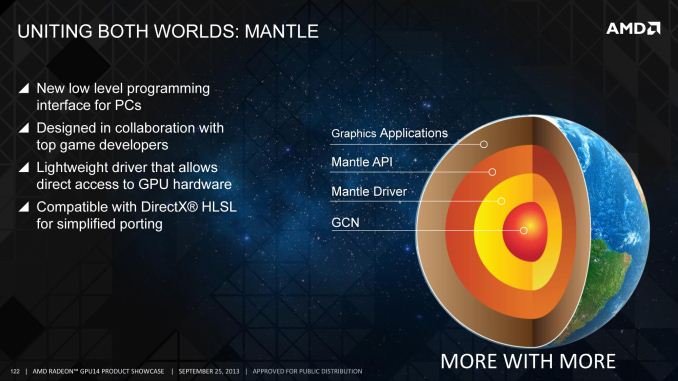
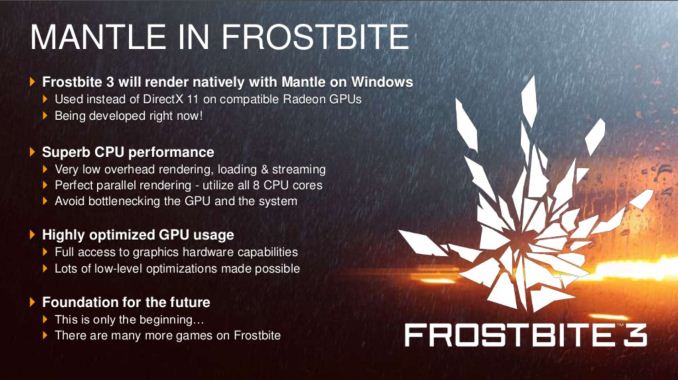
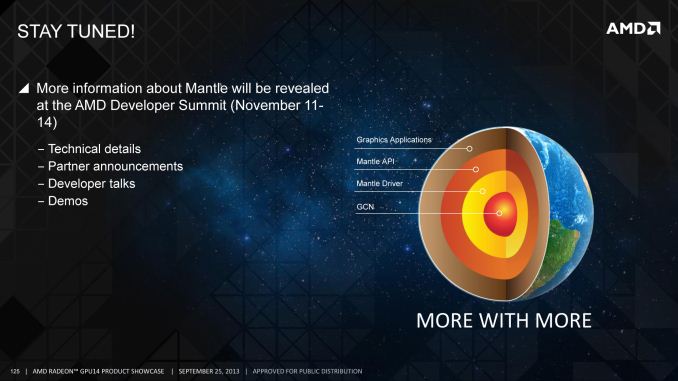








244 Comments
View All Comments
iniudan - Thursday, September 26, 2013 - link
Mantle is an open standard, not proprietary, just no idea what the licensing is yet.All Nvidia and Intel have to do is develop their own architecture and driver, so they can interface with the API.
But yes, for now AMD are the only one who will be able to run Mantle. But they control two important hardware platform, so they can permit themselves to be the one who set standard and give themselves a short/medium term advantage, like how they did back in the early x86_64 days.
jwcalla - Thursday, September 26, 2013 - link
That doesn't jive with the concept of a low-level API. When they say that the Mantle API is open, they just mean the interface that game engines would use into Mantle. Otherwise, if this is just another abstract API where NVIDIA and Intel can just plug in their own stuff, how would it be any different than Direct3D and OpenGL?The article indicates that Mantle is explicitly tied to the GCN architecture.
iniudan - Thursday, September 26, 2013 - link
Current Nvidia and Intel hardware most likely cannot plug into the API, but nothing is preventing them from modifying their architecture and driver to be compatible with the API, has the standard is open.All this does is giving AMD short term advantage, has they are the first one with compatible hardware on the market (HD 7700, HD 7800 and HD 7900 series are GNC) and a long term advantage in the capacity of drawing FRAND licensing revenue for implementation of the standard, if their standard catch on.
jwcalla - Thursday, September 26, 2013 - link
I don't understand how that makes sense. A low-level API that is completely tied to a graphics architecture does not translate into Intel and NVIDIA having the ability to change their drivers to be "compatible" with the API. And there is no "standard" here. It's an API into GCN architecture. That's the opposite of the word "standard". Where are you getting this from?iniudan - Thursday, September 26, 2013 - link
No, it is an API that connect into GCN architecture driver, not the GNC architecture itself.It low level has the API feed directly into the kernel layer driver (unless we are speaking of microkernel), that still not metal you know.
wumpus - Friday, September 27, 2013 - link
Nothing is stopping nvidia and Intel from making a Mantle driver. Nothing but the fact that it will be slower than using directX unless you are going straight to GCN hardware. Possibly much slower depending on how different your hardware is (gods help you if you are using tiled mobile architecture).HisDivineOrder - Thursday, September 26, 2013 - link
Why are you guys so convinced it's the Xbox One low level API instead of, say, the PS4's? I thought that most of the API work done for the Xbone was done by MS and most of the API work done for the PS4 was done by AMD and Sony.That's what I've read when I've read about such things. So why act like Xbone is the only next gen console with GCN hardware coming out? Hell, last I checked, the Xbone doesn't even seem to have a fully HSA-spec'ed part unlike the PS4's fully HSA-capable hardware.
MS had their own version that made it so they didn't require HSA. That's what I was reading a few weeks ago...
So what information is making you lock onto just the Xbone's low level API instead of including PS4 in there?
I'm also curious how you aren't seeing the real problem with this. It isn't that AMD doing it and everyone else stays Direct3D, okay so that's fine. The real problem is this is going to redefine how the TWIMTBP vs Gaming Evolved is going to play out. It's especially going to affect any title that Intel decides to throw its rather HUGE budget toward "owning."
Because if AMD can do Mantle, then nVidia can do something they'll probably tie into CUDA, and Intel will gladly do something to lock out AMD and nVidia. Imagine having to disable your discrete GPU to run your integrated GPU just to play the new Angry Birds. Why aren't you seeing the obvious here?
If AMD who is as cash strapped as any of these three companies can afford to buy a few developers, what do you think nVidia whose entire existence is reliant upon being perceived as the high end (and who has a long history of practically co-developing games, re: Batman AA) is going to do? What do you think Intel who just needs a way to "compel" gamers to use their GPU's is going to do with all that money they have just sitting around in money vaults?
Both of the latter have shown a renewed focus on gaming, especially Intel. They aren't going to sit by and let Mantle take away the high performance crown. They're going to either work together to make their own variant or they're going to individually split the industry in a threeway. How long then before games are ignoring the DirectX codepath except as a vaguely baseline "safemode?" How long before it's dropped entirely if Intel wants to REALLY own that game with a lot of money?
Do you really think the very fragile PC gaming market can handle a sudden and abrupt threeway fragmentation battle over the API's? There's just no way this is a good thing. No way. It might seem like a good thing for AMD users for a brief period of time, but then what happens when the hardware changes in the future and going down to "the metal" isn't the same in future products as it is in current ones? Let's hope no games go exclusively Mantle or we're going to be back to hoping someone "ports" a PC title so it runs in the future on more generalized GPU's that forego "specialized functions" again.
I really don't get why you're so upbeat about this. This is more than just shock and awe. You should be horrified. You should be telling them how horrible an idea this is, how badly this is going to go if it were to gain any traction, and how you pray to the gaming gods that no developer actually uses this.
Because look at what nVidia did with PhysX and imagine what they'll do with the idea of owning an API. Look at the sheer amount of money that both nVidia and Intel have to throw around. AMD is going to lose this war even if they land an opening salvo, but all gamers will lose because there will be a day when all this crap will splash out and hit us. One game or another.
And creating uncertainty in PC gaming right now is snatching defeat out of the jaws of victory.
iniudan - Thursday, September 26, 2013 - link
I actually think your wrong, has Mantle is an open standard.Worse case scenario there is a FRAND licensing attached to implementation, which is something normal for standard in electronic and computer hardware industry.
Basically due to controlling xbox one and PS4, while also having interest in the ARM and x86 market, AMD is trying to implement a low level GPU API standard, that would give them a short term advantage in other market and possibly, if not a royalty free standard, long term FRAND licensing revenue from those licensing the implementation.
Basically AMD is possibly trying to create the GPU API equivalent to WIFI in wireless networking.
wumpus - Friday, September 27, 2013 - link
I suspect that a great interviewing test for marketing shills is to get them to explain how a system that connects to AMD parts can be somehow sold as an "open system".I can only hope that this means that SteamOS will soon have mantle drivers available, and better yet Mantle drivers in the Linux kernel (which would make OpenGL and Wayland development take off).
iniudan - Friday, September 27, 2013 - link
It doesn't connect in the hardware, it connect into the kernel-mode driver.